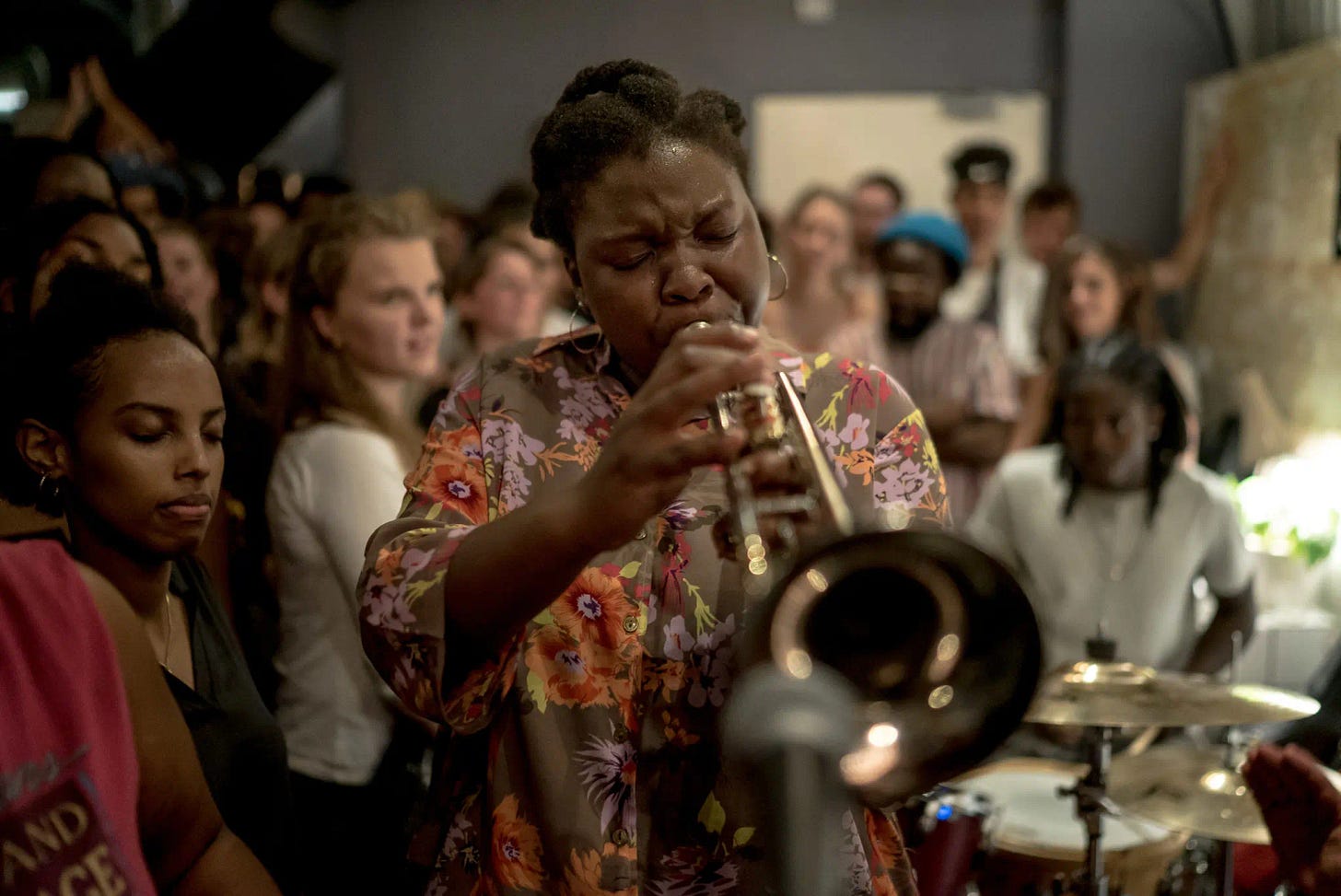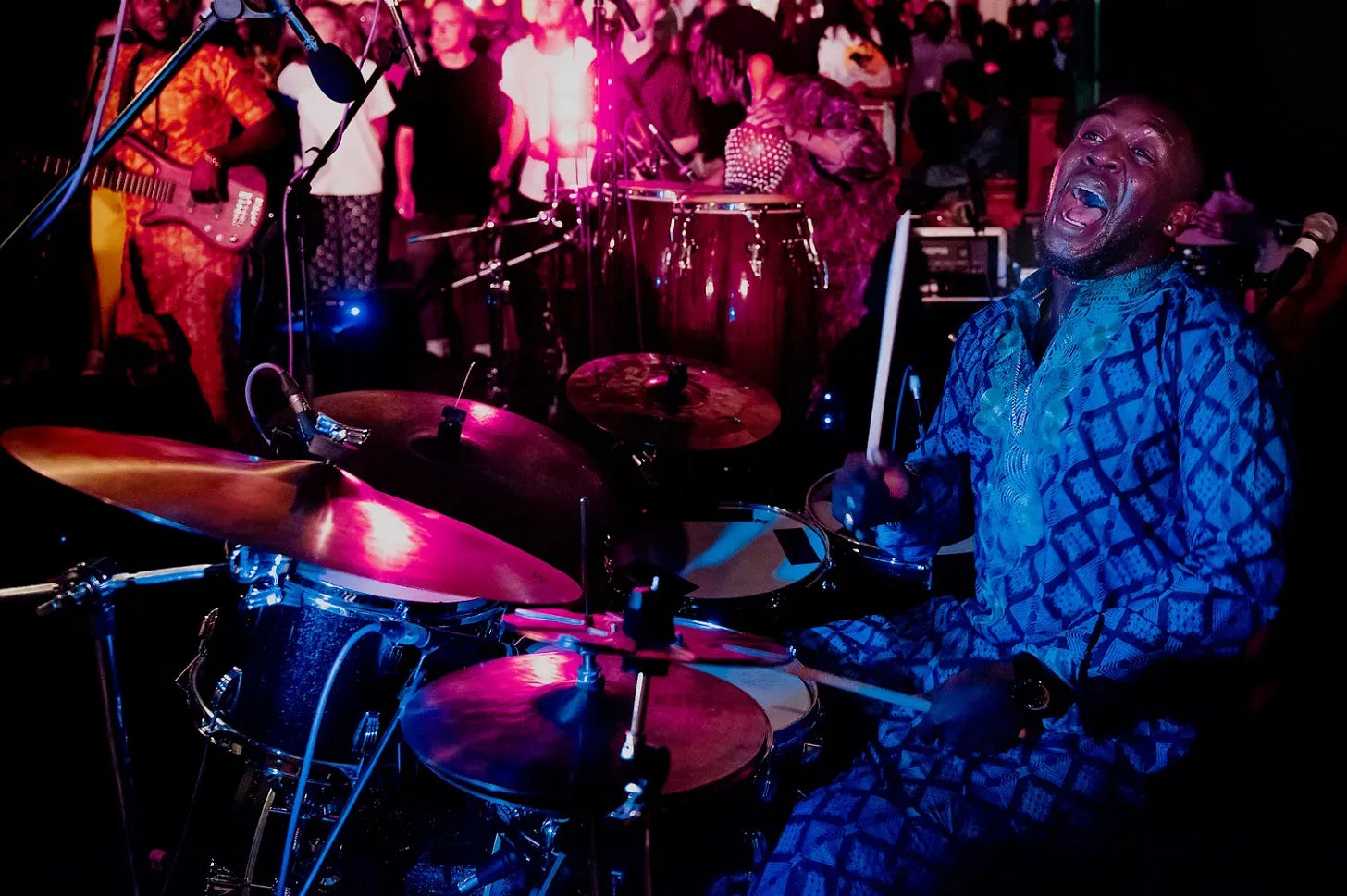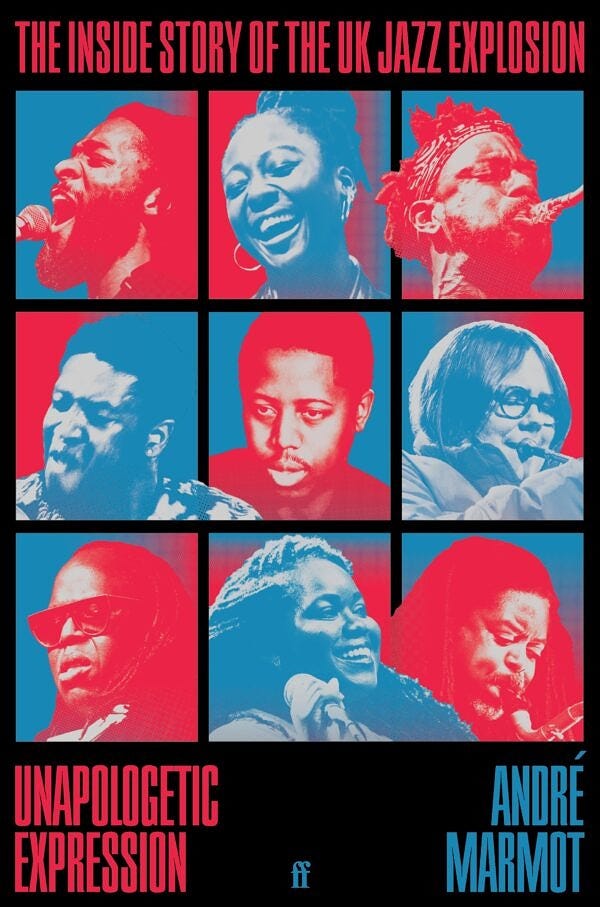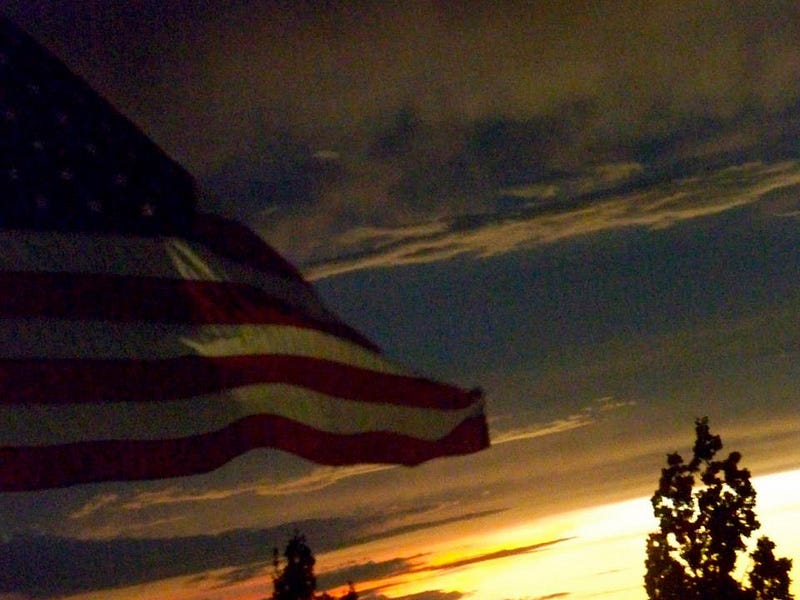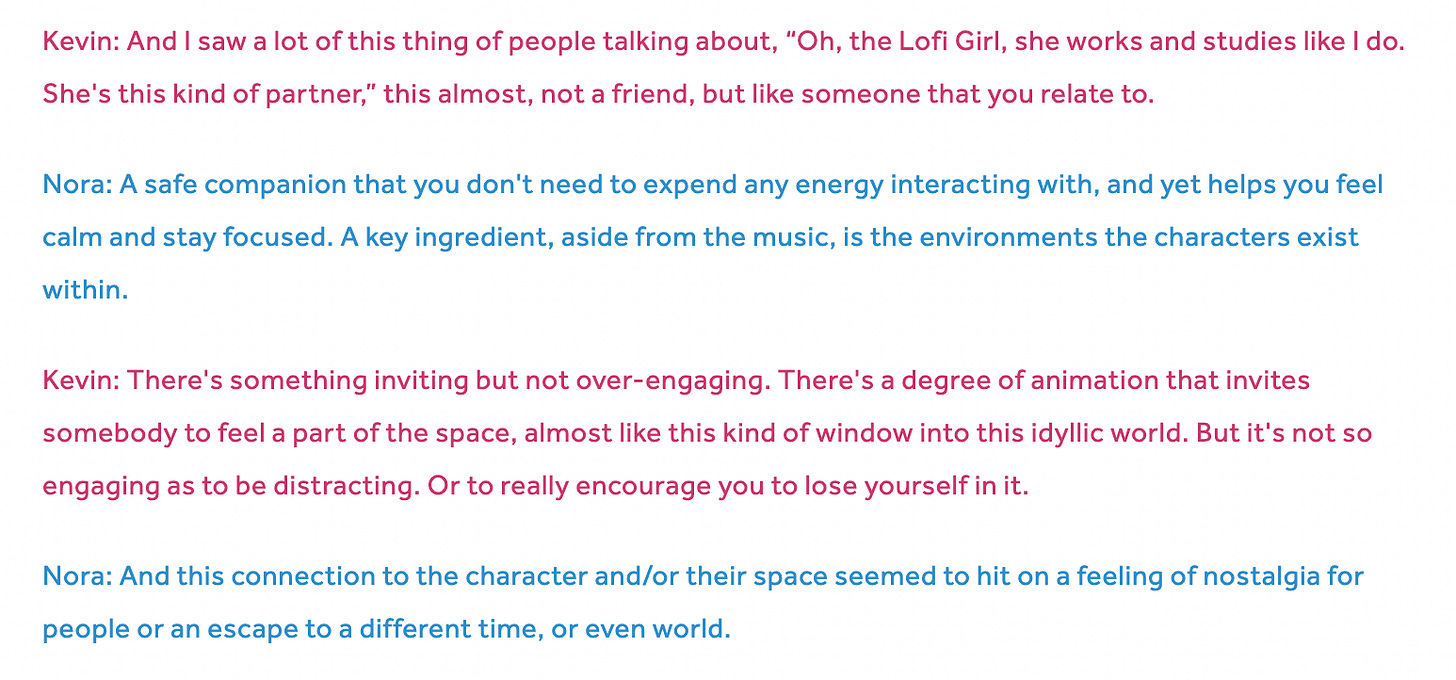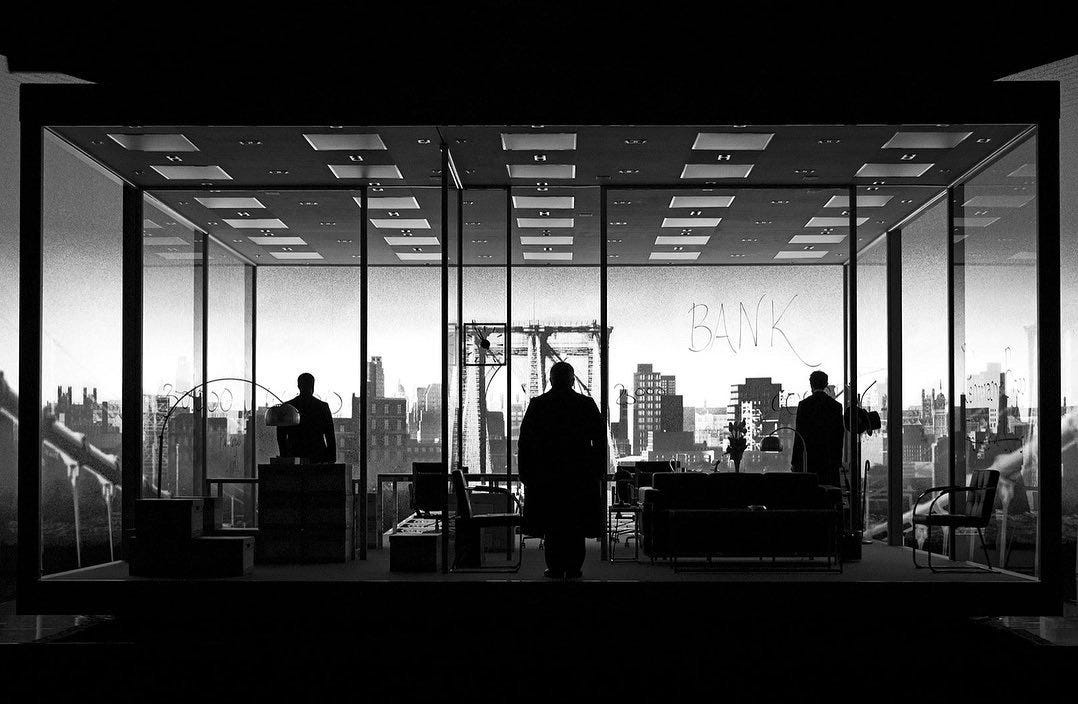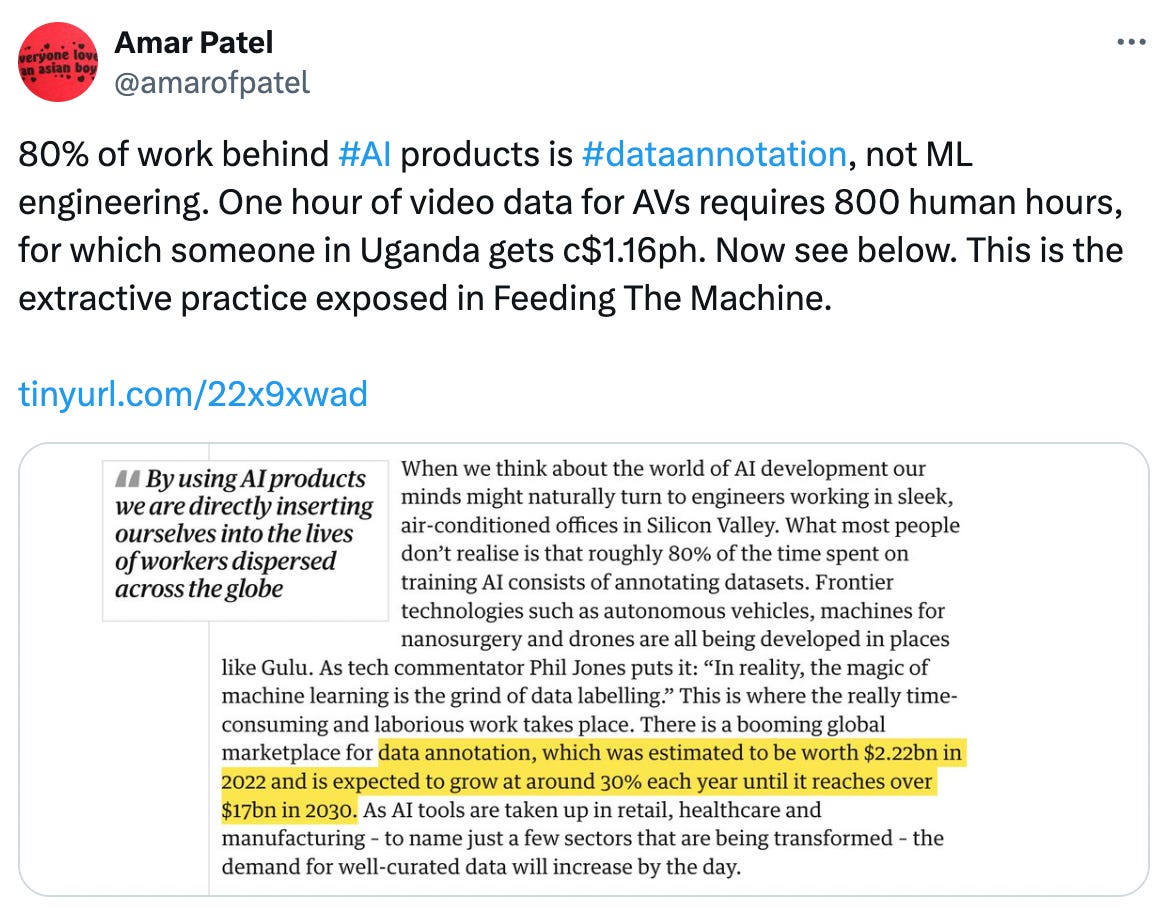Flashes of the spirit
André Marmot's Unapologetic Expression documents more than a UK jazz explosion. It's about kinship, the interconnectedness of things and where culture comes from.
In this issue:
Headliner Debut author André Marmot on a new generation of jazz in the UK and the waves upon waves that got us here
Revival A dispatch from Virginia on 9/11
Aftershow The Lofi Girl keeping millions calm and focused, Gen Z ditching dating apps, The Lehman Trilogy back in business and big questions about the use of AI to write and make art
It’s hard to pinpoint when the vibe shifted in London’s live jazz+ scene. I had been floating around its nether regions and writing about it since 2004. An extended apprenticeship at Straight No Chaser magazine and listening to broadcasters such as Gilles Peterson had turned my head from the totemic US canon towards a lineage of influential figures on this mish-mash of an island.
A smattering of touchstones from the 60s through to the early 2000s: Tubby Hayes, Michael Garrick, Stan Tracey, Joe Harriott, Don Rendell & Ian Carr, Graham Collier, Chris McGregor’s Brotherhood of Breath, Jazz Warriors (Courtney Pine, Steve Williamson & co), Chris Bowden, Kaidi Tatham, Jason Yarde, Robert Mitchell, Seb Roachford and Polar Bear.
During this period, a continuum of scenes and sounds, it was impossible to ignore the role of organisations such as Tomorrow’s Warriors (co-founded by The Warriors’ Gary Crosby and Janine Irons) and jazz re:freshed in providing both laboratory and springboard for emerging players. Future-focused yet pedagogic and respectful to the past.
Current ‘graduates’ and affiliates flying high include Nubya Garcia, Moses Boyd and Ezra Collective, who all feature in Unapologetic Expression, André Marmot’s account of the current UK jazz explosion. Here’s the thing. For all the great interviews, features and reviews that have been written about individual artists and movements over the past 30 years or so, no one has stitched together that history into a coherent narrative. Until now.
Marmot is well placed to have a go, as he has worn multiple hats for more than 10 years including musician with Afriquoi, a label manager and booking agent for the likes of Nubiyan Twist and the influential United Vibrations (whose Wayne Francis inspired the book’s title).
“I think for the first time, a lot of musicians are really fearless in representing the cultures they come from, and bringing that into what they create”
Wayne Francis (United Vibrations)
Between 2020 and 2021, the author made good use of everyone’s curtailed freedom by conducting 86 interviews. “The strange stillness bookended years of intense and organic growth for the scene and its major players,” he writes.
On the volatile atmosphere following the murder of George Floyd, Marmot adds, “The event and its aftermath provided a framework for me to ask interviewees direct and difficult questions about racism and identity, for which I believe the book is much richer.”
Unapologetic Expression tries to place ‘jazz’ in its socio-political context. As a “black music of rebellion” with origins as far back as the 18th Century. How the Code Noir under French Catholic rule in New Orleans drove traditional vodun rituals (singing, dancing, drumming) underground, “bringing its practitioners together in joyful, defiant self-expression”.
How the exploitation and displacement of indigenous people across the Empire dispersed seeds of new cultural and creative revolution across the UK, especially the capital, and set in motion wave upon wave of sonic innovation.
One of the key through lines of the book is how we went from this – via some of the major artistic statements of the 20th Century by black musicians – to jazz being derided as effete, pompous and self-indulgent. See Louis Balfour in The Fast Show (“Niccce”).
On to 2019 and you had Vice parodying the Nu Jazz Lad, hailing a youthful resurgence happening in SE London and how “jazz is becoming the alternative music of the 21st century”. A curt approximation of the book’s timeline but more than illustrative. How had this music lost touch with its innate purpose?
Anyone who attended a jazz re:freshed weekly live performance in the early 2000s – along with shows at respected venues such as Ronnie Scott’s, Vortex and later the even more experimental Café Oto – might contest this steep decline that preceded the explosion. Some of the acid jazz generation also.
Let’s put it this way: there was a certain point post-2010 where we began to see a whole new generation of artists, predominantly young Black British, taking to the stage with their own articulation of the form.
The energy was different and Marmot makes this connection well in the book. How incubated club scenes, many of which had drawn on some element of jazz, began to influence musicians; the way they played their instruments and produced the records. A greater physicality and anarchy in the sound. Liberation in personal expression.
"Jazz is whatever you are... playing yourself, being yourself."
Mary Lou Williams
Dave Okumu, a key figure in so many contemporary strands of UK independent music, talks about his experience taking ensembles of very accomplished musicians at Trinity Laban and struggling to get them to open up. “… it took them a long time to feel they had permission to explore themselves,” he explained. “It felt like I was dealing with people who had been told what they should be for quite a long time.”
Not so in this new generation, who came of age on the floor, as much as the bandstand, absorbing a plethora of sounds on dubplate, 12” or however they could get it. What mattered more than genre, purity or virtuosity was being able to flow in the moment. The sound was whatever it needed to be right then, to paraphrase another featured artist, Cleveland Watkiss, the distinguished link between jazz vocal and MC.
"Jazz is the type of music that can absorb so many things and still be jazz”
Sonny Rollins
You can follow the long tail from Metalheadz for jungle and drum n’bass heads to FWD and Co-Op club nights, ground zero for dubstep and broken beat at Plastic People, to name a few. The shockwave that was/is grime transmitted through DVDs (Lord of the Mics, Risky Roadz), pirate radio (Rinse FM, Deja FM) and online TV (Channel U, SB:TV).
And let’s not forget the debt owed to sound system culture, blasting dub, reggae and more across neighbourhoods and generations. The ultimate binding force in frequencies when it comes to communing in person.
On a live front, you had multidimensional Steez in South London cultivating a deep respect between loyal audiences and emerging artists. Then Total Refreshment Centre (TRC) in Dalston becoming a hangout and recording studio for this new generation, as well as a beacon for kindred spirits abroad including Chicago label International Anthem.
Out of TRC came Church of Sound, which presented this music with the reverence it deserved, while making vital links to artists and songbooks of the past. Back down south, jam session Steam Down inciting a collective effervescence and pulsating far beyond its little corner of Deptford.
This was the vibe.
The always engaging Femi Koleoso, of Mercury Music Prize winners Ezra Collective, encapsulates the shift in one of the best, most succinct quotes from Unapologetic Expression. “We made jazz sound like London, d’you know what I’m sayin’ fam?” Feels right.
I remember a raucous gig around 2017 where tuba player Theon Cross (who has played sousaphone on stage with Kano at Glastonbury) was dropping this grime-y bassline that ricocheted around the room, hyping the crowd, while Nubya’s shrieking sax spun us out like a siren. In the back, Moses was pounding out a beat, nasty and unfussy. It was all so live and direct. Rave energy.
Something I also felt around Theon’s Sons of Kemet bandmate Shabaka Hutchings, although he can conjure intimacy and intricacy in a breath. Shabaka’s recollection of playing arenas with Red Snapper was telling. An early realisation from one of the younger elders of this music’s potential to move the masses. “It was the first time I played proper big rave clubs on big stages. And it did show me a lot about what’s possible in terms of being able to play creative music for large audiences.”
Marmot’s book reminds us of the interconnectedness of things, the importance of building a tight-knit community to collaborate on each other’s projects, push and encourage one another. A sparky convergence that builds excitement and holds interest. How else can you grow and sustain a culture, particularly in economically challenging times?
Some might take issue with Marmot’s focus on the capital in a survey of UK jazz, which is fair, but it has been the epicentre. The author does make links to bridging modernists such as Robert Glasper, Kendrick Lamar collaborator Kamasi Washington and The West Coast Get Down, plus Flying Lotus and LA’s Low End Theory. All have helped to revitalize jazz by widening its parameters.
Others might lament the exclusion of the avant-garde in the UK. But overall, Marmot deserves credit for taking stock of these movements thus far and collating their history in such an informative and lucid manner. Inserting key voices into the narrative, like an oral history, worked well and made me want to listen to the full conversations.
As he concedes, artists and grassroots venues of note are here today and gone tomorrow. In these chapters, there may be the inspiration or impetus for what comes next.
Unapologetic Expression is published by Faber & Faber. Here is an accompanying playlist by the author. Possible Q&A with André to follow.
Shook
A first summer abroad should be a once-in-a-lifetime adventure for a university graduate. Unforgettable it was – for all the wrong reasons
Tuesday.
Another day, another dollar.
Pick a street.
Look for clues.
Ask questions.
Beware the dog.
Knock knock. There I stood waiting, side on, a few paces back from the entrance just as we had been taught. A forced smile. Contorted. A grimace of desperation.
"You are a professional educational consultant,” my inner coach boomed. “You can do this.”
The door opened. In front of me stood a hulking figure, in ripped denim jeans, sleeveless check shirt, stubbly face and a frayed trucker's hat. Under which sat two piercing eyes; the kind that meant trouble. A menacing caricature made flesh.
It was the look of a man with nothing to lose. Before I could get into my stride and explain why this charred stranger was standing there with a big bag, a clipboard and a weird accent, he reached to his side and pulled out a shotgun.
Raising it slowly and pointing it at my midriff with real intent, he hissed these chilling words: "Boy, you got a lotta nerve showing up right now. Get off my porch."
How had it come to this?
Well… Earlier that year, naive and impulsive, I had signed up for a business programme selling educational handbooks to families door-to-door. I would have to raise all the money for flights, two weeks of training in Nashville, accommodation, food and 'office supplies'.
I still remember the look of disappointment on my dad’s face as he reviewed this raw deal and reluctantly signed the consent form. As if to say, why did I waste money on your education if you’re going to make dumb choices like this?
Upon arrival in my designated area – Roanoke, Virginia, a sleepy, hilly expanse known as the "Star City of the South" – I would have to go from door to door asking if anyone had a spare room to let that summer. As for the work, it was based on 100% commission so no guaranteed wage.
Why do it? The thrillseeker in me, perhaps. I had been seduced by the road, the rebellious sense of adventure that crackled on every page of Kerouac. It was time to walk a reckless path, well away from my comfort zone. Buy the ticket, take the ride as Hunter S Thompson wrote before going full Gonzo.
The trip was beginning to take its toll. Thoughts of colleagues who had jumped ship, poor sales and the fallout from countless six-day weeks of fourteen-hour toil in maddening humidity. Even a few close calls while peddling along the freeway in the pitch-black night.
The neighbourhood I was working in seemed quieter than usual. No toddlers playing with their house-bound 'moms'. No nannies juggling duties. No traffic. Greetings at the door were more hostile than usual, accompanied by this traumatised stare.
Confederate flags were drooping half-mast beside the stars and stripes.
On to the next house. An elderly lady – the church-going type – recoiled from the door. “You should be ashamed of yourself,” she growled, before slamming it in my face.
I moped along, confused. What was I missing? A public holiday, a zero-tolerance policy on peddlers, my unkempt appearance?
Got to keep going.
I turned the corner, surveyed the street and singled out a beautiful white bungalow with a "welcome" mat and copious flower beds delightfully arranged around the exterior. It looked like the sanctuary I needed. Worth a try.
A compassionate Irish lady ushered me in with worrying urgency. Inside, the television was on full blast. It sounded like an episode of NYPD Blue.
“A plane has just crashed into the towers.”
She paused, gazed out of the window for a moment and continued. "I think my son-in-law’s in there,” she muttered. “I’ll fetch some tea."
11.09.01
Lofi Girl
Have you met Lofi Girl? The YouTube channel offers an anodyne loop of instrumental beats to soundtrack her scribbling and our study … or sleep. It’s very functional, unobtrusive music. A super-chill, understated phenomenon with more than 14 million subscribers and 688 million views.
I find it largely ignorable as someone raised on hip-hop beattapes by DJ Shadow, DJ Krush, RJD2, J Dilla, Dimlite, MF DOOM, and Knxwledge. But that’s the point. It’s not there to steal your attention or distract us with its head-nodding brilliance, as this fascinating Twenty Thousand Hertz podcast uncovers.
Hosts Ben and Nora speak to fans of the channel, researchers and a music therapist to better understand its appeal. Lofi Girl has been a godsend to neurodivergent listeners in particular, helping them feel more calm and relaxed.
One interviewee used the word “safe”. The sense of community that has formed around the channel, the support network it’s created, reminds us of the true potential of the internet to form bonds among people who may never meet. Also, the benefits of feeling connections to fictional characters and places.
Purists may criticise the quality of the music, lament the decay of artistry and how algorithms have decimated the value of creativity. But they will be surprised by the story of a producer called Antonio who has developed a huge listener base through the channel and earned money from both streams and music releases through Lofi Girl.
The Lehman Trilogy
London theatre lovers, rejoice. Ben Power’s adaptation of Stefano Massini’s epic tale of vaulting ambition and mounting greed is returning to London.
Covering three generations of family history over 164 years, The Lehman Trilogy has tested and conquered audiences from the Southbank to Broadway since premiering in 2018. As long as there’s a gold rush to hawk, and lives to ruin, it will remain as relevant as ever.
I caught the production last year and although the cast is different, Sam Mendes is still in the director’s chair and Es Devlin conceived the spartan set design. Come get a taste here and then book your seat. It’s on from 24 September until 5 January.
“Looking into their crystal ball, they said you too can make it, trust me, but act now or miss out. Lehman gets rich in the process and as a result, they only want to get richer while the get-rich philosophy in a capitalist society brings more fresh fish to the trawler. But there’s only one problem as Lindsay points out while in narrator mode: ‘What happens if they stop believing?’”
Why AI isn’t going to make art
Not a day goes by without stumbling on several articles or posts about this. Most of them eschew nuance in favour of sensationalism: AI is either going to unleash creativity or pose an existential threat to artistry and humanity.
The last one I read, a musing on authorship by
, The Content Girl, was more contemplative but no less direct. Are you still a writer if you use ChatGPT?“So, I have a question for you. If I come up with an initial idea, decide on tone/messaging/format/structure myself, and write my own draft, but every now and then, I add a word or phrase or statistic I asked AI for, can I still claim the end product is 100% my own work?
“I think so. And if you agree with me, then at what point would it stop being my work? Is it when I let AI phrase a full sentence? When I let it write a whole paragraph? Two paragraphs?”
She floats the idea of someone writing a series of specific prompts for the AI to generate a whole novel and likens it to being a creative director. I started to think of this in terms of cinema and how the director helms the vision for a piece of visual storytelling (that hinges on a screenwriter, it must be said). Is that where literature is heading? The realm of delegation? A human-computer writers’ room?
The art and design worlds have benefitted from AI- and machine learning-enhanced software for years. Tools to streamline the creative process and save time. Somewhere along the line, the focus rapidly shifted from professionals tweaking their work to relative novices prompting things from scratch based on other people’s work. Here’s a quick timeline.
I see no issue with writers using the technology to brainstorm, plan, research, either expand vocabulary or refine the language, edit and then fact-check work. An opinion I shared with my mentee last week as she agonised over school coursework deadlines. But the minute that writing sentences and paragraphs becomes the generating of copy, alarm bells are ringing.
Aside from prompting a couple of DALL-E 2 illustrations to accompany blog pieces and two attempts to find more catchy headlines (which were underwhelming), I haven’t bothered to experiment too much. It felt like too great an abdication of the writer’s responsibility, which I am clearly precious about. It’s only been a craft I have pursued diligently for half of my life – no big deal.
The ethics become very contentious regarding intellectual property. I have a big problem with a small group of speculators reaping a fortune from the creativity of others. Not to mention the exploitation of cheap labour for data annotation, to keep this extraction machine running.
It’s a lot easier to get excited by AI’s potential in medicine. Earlier breast cancer diagnosis could literally be a life-saver. When it comes to art and creative expression, I am more skeptical. Ok, who wouldn’t want to steal back time spent on more menial tasks, like transcribing interviews or organising files?
The trouble is, human beings are often too quick to take shortcuts when actually doing the work is how you get really good at something. Good taste is not enough. Speed and convenience are overly pressing factors in the decisions we make as the world becomes more complex, competitive and congested.
As I mentioned in the last issue, I’d hate for us to get to a situation where, in the words of musician Nick Cave, “The creative experience is seen as an impediment on the road to the product itself.”
Which leads me to this impassioned argument from Ted Chiang. For the acclaimed science fiction author, our ability to encounter unfamiliar situations and make our own choices is fundamental to the nature of art. As it stands, this technology uses training data to either take an average of potential choices (based on others’ work) or mimic the style of someone else.
I like this analogy.
“Using ChatGPT to complete assignments is like bringing a forklift into the weight room; you will never improve your cognitive fitness that way.”
And this is the crux of human creativity. AI could (probably) never…
“Whether you are creating a novel or a painting or a film, you are engaged in an act of communication between you and your audience. What you create doesn’t have to be utterly unlike every prior piece of art in human history to be valuable; the fact that you’re the one who is saying it, the fact that it derives from your unique life experience and arrives at a particular moment in the life of whoever is seeing your work, is what makes it new. We are all products of what has come before us, but it’s by living our lives in interaction with others that we bring meaning into the world.”
Can I leave you with one more sunny thought about this field? The potential for deception goes far beyond plagiarism. How about a bigger betrayal of trust that opens you up to manipulation, theft or reputational damage? I know we’re in a post deep-fake world but listening to this podcast about journalist Ben Ratliff’s attempt to create an AI clone of himself was just wow.
The Atavist co-founder trained it using ChatGPT and fed the voice agent a long biography he had written before deploying it in conversations with a BetterLife therapist, friends, interviewees and potential collaborators.
Although the latency, its emotionless cadence and steadily sober manner are giveaways, the improvement over the six episodes is impressive. As is the ability to think on its feet. In Ratliff’s opinion, “We're not spending much time considering the inevitable everyday interactions that we're gonna have with these AIs all the time.”
He wanted to understand the discomfort many of us will feel when these agents are commonplace in society. The potential applications are fascinating, of course. At one point, Zoom CEO Eric Yuan welcomes being able to dispatch his clone to attend a meeting in his place. Ok, that bit doesn’t sound so bad.
But it’s the nature of interactions that I wonder about. Will knowing you are speaking to someone who is not real, make you less or more forthcoming in the conversation?
The meet-cute’s revenge
Let’s conclude with some dating chat, shall we? You know my heart is wide open on such matters. There is no shortage of critiques about apps and a marketplace approach predicated on an abundance of choice and snap judgments. And what about the paradox in the room: do matchmaking and moneymaking go together?
We’re in the midst of a rebellion and the numbers don’t lie. Match Group, which owns Tinder and Hinge, reported a decline in its total number of paying users, for seven straight quarters. Shares in Bumble crashed 30% in August after a bad earnings report.
Sarah Thankam Mathews’ feature from earlier this summer focuses on the native swipers of Gen Z and their attempts to find romance in other ways. From book clubs and bike groups to date-me docs and newsletter classifieds.
Here is a heartening observation, which feels connected to the point above about convenience and using tech to find a shortcut. A quick answer to the riddle of human desire. It’s a reminder that attraction might be where we least expect it, far away from profiles and preferences.
“What those who run dating corporations either do not understand or choose to obscure is that romance, eroticism, and what we might call love have nothing to do with efficiency and everything to do with the ineffable mysteries and vagaries of the self. How someone grows. How someone responds to another. How someone realizes desire, moment by moment, both changeable and patterned as weather. How one understands oneself in relation to a wider world – a social world. What the world of tech has framed as inefficiency, it turns out, might play a crucial part in figuring out who you are and what you want."




